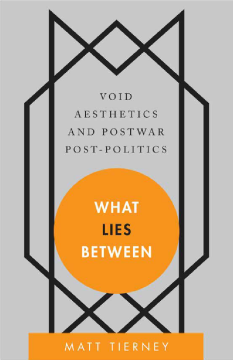
Additional Information
Book Details
Abstract
By what aesthetic practice might post-politics be disrupted? Now is a moment that many believe has become post-racial, post- national, post-queer, and post-feminist. This belief is reaffirmed by recent events in the politics of diminished expectations, especially in the United States.
What Lies Between illustrates how today’s discourse repeats the post-politics of an earlier time. In the aftermath of World War II, both Communism and Fascism were no longer considered acceptable, political extremes appeared exhausted, and consensus appeared dominant. Then, unlike today, this consensus met a formal challenge, a disruption in the shape of a generative and negativist aesthetic figure—the void.
What Lies Between explores fiction, film, and theory from this period that disrupted consensual and technocratic rhetorics with formal experimentation. It seeks to develop an aesthetic rebellion that is still relevant, and indeed vital, in the positivist present.
By tracking the generative figure of the void in mid-twentieth-century American fiction, cinema, and criticism, and by articulating that figure to questions of medium, intermediality, race, narrative, communication, and community, Matt Tierney offers not only an original statement on aesthetic form but also an informed critique of the technological complacency of our time. Written with remarkable learning and subtlety, this book makes us appreciate anew the vital indispensability of political dissensus.
Rey Chow, Anne Firor Scott Professor of Literature in Trinity College of Arts and Sciences, Duke University
The nature of the aesthetic object is the fundamental question behind Matt Tierney’s What Lies Between[, which] powerfully uncovers the space of resistance that formed around the cybernetic ideal of perfect communication ... This literary-historical work not only challenges the very idea of a fully coherent postwar consensus culture that would not break until the 1960s, but also convincingly argues that the concept of negativity...[became] so popular in part because Americanists had already been thinking in those terms ... Rehistoricizing American studies to crack open the black box of technological mediation, Tierney shows the critical purchase that can be gained on media infrastructures if the medium itself can be seen as a historically contingent and socially contested object that contains within itself traces of struggle, protest, and failure.
Tierney traces a 'void aesthetics' from the mid-20th century to the present in the work of novelists such as Richard Wright and Ralph Ellison, filmmakers such as Orson Welles and Jonas Mekas, and the critics of the 'Melville revival,' especially Richard Chase, that challenges the stability of consensus. . . .Summing Up: Recommended. Upper-division undergraduates and above.
Ex nihilo nihil fit. Out of nothing, nothing comes. Matt Tierney puts insistent and subtle pressure on this ancient cosmological and philosophical chestnut by recasting nothing as void. And, as one might expect, what comes out of the void is far from nothing. Situated initially in the literary, critical and filmic practices of figures as diverse as Richard Wright, Jonas Mekas and Paul Goodman, void is shown to generate a medium of aesthetic politics that, in the end, Tierney wants to call Melvillean. As the reference to Melville might suggest, this resourceful and principled meditation on the void and its textual iterations—blankness, darkness, negativity, the silhouette—is a bold disruption of the dispersed field of American literary and cultural studies, one that moves to gather the void into a point: it offers us a way to keep the future open and avoid succumbing to the deadlock of a presumed post-political era of contemporary America, a national project indefinitely suspended between utopia and nostalgia. Dissatisfied with merely pointing, Tierney concludes by teasing out of a work like Kara Walker’s Subtlety the nothing that connects us to potentia, power and possibility. Now that’s something.
John Mowitt, Leadership Chair in the Critical Humanities at the University of Leeds
Matt Tierney is Assistant Professor of English at The Pennsylvania State University in University Park, Pennsylvania, USA
